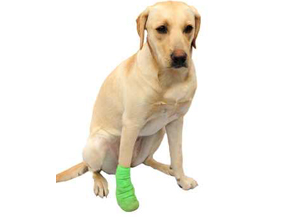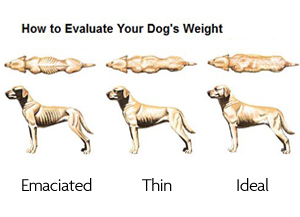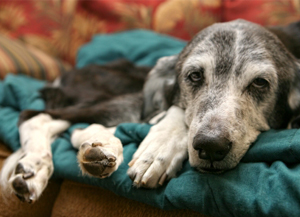
Lameness Muscle Loss
Many times, after a long lameness or an illness, animals suffer muscle loss. This can be manifest by having an obviously smaller diameter limb, or by showing signs of general weakness. The muscle groups most vulnerable to this type of loss from inactivity are the central core muscles, and those used to extend the limbs. They are of a different type of muscle than the other muscles of the body.
All muscles are not the same! A leg that is held off the ground and not used because of injury or pain suffers a rapid loss during the first week of immobility, with loss continuing more slowly for the next 5 weeks. As an example, we have a dog that started rehab after surgery for a fracture repair. The surgery was seven weeks prior, and he was still holding the leg up. Measurements of muscle diameter in the thigh and calf area showed a 13% loss of muscle.

Muscle Loss
Why does the muscle shrink like that? Several interesting reasons; prolonged immobility causes an alteration in the energy-producing portions of the individual muscle cells, and an alteration in the portion of the muscle cells that controls the calcium (which is responsible for the ability to contract).
Major enzyme pathways are drastically slowed and decreased, which results in reduced energy production, as well as reduced protein production. As these normal functions slow, inflammatory proteins are enabled, and cause further tissue loss. The cells lose the ability to properly respond to insulin, so their energy is further decreased.

Arthritic Dog Muscle Loss
Think about the older, arthritic dog. They hurt so they lay around all day. We feel sorry for them and give them extra snacks. No exercise and extra snacks leads to weight gain, and it’s even harder to move a heavier body on sore legs, so they end up with muscle loss and weakness as well.
Researchers estimate that it takes twice as long to regain muscle tissue than the time it took to lose it in the first place. If the atrophy is severe and long standing, the animal may never recover all the way to normal. Early rehab and exercise goes a long way to preventing the severe loss that can occur after a painful injury and surgical repair. Older arthritic dogs can safely exercise also. If the animal is unwilling or unable to use the limb to do the exercise, we often use a mild form of electrotherapy to cause muscle contraction and get the muscles active. Even a little motion goes a long way towards avoiding permanent deficiencies.

Recent Comments